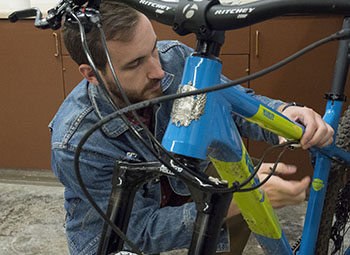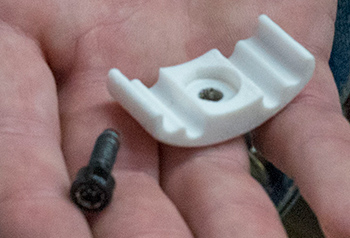 Housed in G026 Rutledge Building, the CreatorSpace gives students, faculty, staff
and the community a place to "converge and create," offering items such as video production
equipment, an audio isolation booth, a Yeager Theatre Light Lab and 3D printers.
Housed in G026 Rutledge Building, the CreatorSpace gives students, faculty, staff
and the community a place to "converge and create," offering items such as video production
equipment, an audio isolation booth, a Yeager Theatre Light Lab and 3D printers. Davis used the space's 3D fused deposition modeling printer (FDM for short) for his
creation.
Davis used the space's 3D fused deposition modeling printer (FDM for short) for his
creation. 

ROCK HILL, SOUTH CAROLINA When Andrew Davis '14 noticed the new bike he ordered had arrived without cable guides, he didn't call the
bike company and ask for the parts.
Instead, he used the 3D printer in Winthrop University's CreatorSpace to make them.
"You can't really ride without the cable guides," said Davis, instructor and fine
arts lab technician at Winthrop. "They keep the cables along the frame. Without them,
your cables would just be flopping around."
Housed in G026 Rutledge Building, the CreatorSpace gives students, faculty, staff and the community a place to "converge
and create," offering items such as video production equipment, an audio isolation
booth, a Yeager Theatre Light Lab — and, of course, 3D printers.
Davis used the space's 3D fused deposition modeling printer (FDM for short) for his
creation, favoring the printer's definition and precision. The printer works by extruding
plastic filament in layers along an x-and-y axis. The layers build up over time as
the print table lowers.
"You're making something that didn't previously exist outside of a theoretical 3D
modeling space," he said.
While Davis said the company could have easily sent him the parts, he was attracted
to the idea of creating them. He used CAD (Computer-Aided Design) software to design
the cable guides. It took about an hour of design and a few hours to print and modify
the finished product. He made a total of three cable guides for approximately $5.
In comparison, the cost of the part from a manufacturer would have been about $20.
"It's a cool process in that you're brainstorming and refining your prototype as you
go," he said. "You can work out the kinks in your mistakes. You can do your design
work and have multiple things going at the same time."
But the major question — did his cable guides do the trick? Yep!
"It was an interesting process and a challenging thing to do," he said.
Davis holds a degree in studio art from Brevard College and a Master of Fine Arts
from Winthrop. He began adjunct teaching at his alma mater in 2013.
For more information, contact Nicole Chisari, communications coordinator, at 803/323-2236 or chisarin@winthrop.edu.